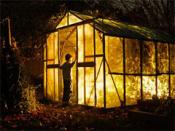Search
Login
Recommended
How to make a mixborder, choose plants for it and fit into the landscape design of the site
When starting the conversation about mixborders, first of all, we note that their creation is a rather complicated process, it requires knowledge, the ability to arrange plants according to the flowering period, decorative characteristics, and dimensions so that the result is a complete picture, so beautiful that you can’t take your eyes off. This type of flowerbed is a ribbon consisting of grouped plants that are in very close proximity.
Content
What is a mixborder

An idea of \u200b\u200bthis type of flowerbed can be obtained by its name: in translation from English it sounds like this: mix - mixed, border - border. In form, the mixborder is a beautiful flowering strip along the path, lawn, planted shrubs and trees. It can have both flat and curved, elongated in length, having irregularities and protrusions of a ribbon-like shape. Its width can vary from 1.5 to 2.5 m. It is precisely this width that allows you to plant enough different plants to create an interesting composition and at the same time provide easy access to them if necessary.

If you want to create a wider mixborder, you should provide tracks in it or lay several paving slabs on its territory, becoming on which you can get to any of the plants growing on it. This will allow you to carry out all the care operations without problems: loosening and weeding, watering and pruning flowers.
The choice of plants for mixborder

Most often, looking at the mixborder in the photo, you can see flower beds from perennials adjacent to annuals. For their proper selection, it is imperative to study the timing of flowering and allocate a place for planting in such a way that this process continues throughout the summer, until late autumn.
It will not be difficult to find recommendations for creating this type of flower garden, if you will be doing the work for the first time, then you will also need a mixborder scheme.

It describes in detail the planting order. The mixborder scheme can have something like this: in the first row - an undersized geranium of Enderss, then - a cuff, 3 row - majestic geranium, then - whorled coreopsis, shrubby cinquefoil, yarrow, in the seventh row you can plant decorative onions, in the eighth row - fennel polygon, then verbena can come, the next is a boxwood shrub, trimmed in a special way, wormwood, wrinkled polygon, in the next row - purple coneflower, then - hathma, unsurpassed in beauty white and red cleme can complete the composition yews.
Of course, you can make some adjustments to this scheme, but very carefully, taking into account all aspects: the color of leaves and flowers, the timing and duration of flowering. When choosing a mixborder scheme from perennials, one should also take into account: the type of soil on the site, lighting, moisture. You should not strive to plant a very large variety of plants - the composition can be built on a repetition of your favorite plant group.
Designers distinguish two varieties of mixborders - monochrome and multicolor.
Monochrome is a composition of plants with flowers of the same hue, but of varying intensity, it is also called coloristic. When creating, one should take into account the need for a smooth transition of shades, as well as the influence of the chosen color on the emotional state of a person contemplating it. Shades must be selected very close. An interesting stylish option would be a mixborder created from plants with green flowers. Suitable for its creation: arisema, anticlay, coneflower Green Gewel, euphorbia, hellebore, green-flowering selection tulips, gladioli, chrysanthemums, lilies.

The effectiveness of the multicolor option is based on the contrast of the components, it surprises and pleases the eyes with festivity. The inclusion of ferns and hosts in it will give a special charm to such a composition. To create such a mixborder, plants are used whose colors are on different sides of the chromatic circle. Considering such a flower garden a person experiences a surge of vivacity and positive emotions. An ideal combination of colors for such a flower garden can be considered blue-yellow, lilac-orange, yellow-red.
Unusually and spectacularly looks the option created exclusively from deciduous plants that are decorative. Since the leaves have different shades, shapes and sizes, it will not be very difficult to compose an attractive composition, and the spectacular appearance during spring-summer-autumn will certainly be provided for it.
Choose a style

Also, before creating a mixborder, you will need to choose a style. In modern garden design, more than ten of them are known, each of them is characterized by a certain set of plants. Experts emphasize that when selecting plants, attention should be paid to the so-called physiognomic type of plants - in other words - the image that is associated with them. Each planted plant should correspond to the general idea and image of the flower garden being created. Otherwise, achieving an impressive result is simply impossible. Although the concept of the physiognomic type is rather subjective, it is possible to clearly distinguish the type of plants suitable for each of the styles.
Let's look at some examples.
The rustic style of the mixborder is characterized by the presence of simple, familiar colors from childhood: rudbeckia, phlox, chamomile, lupine, mallow, Turkish carnation, possibly dahlias. An excellent addition to them will be annuals: nasturtium, feverfew, cosmea, calendula, sunflower. Roses, lovage, fruit bushes (gooseberries and currants), edible parsley and salads will be appropriate in it.
For the forest type, plants that look good against the background of large spruce or birch trees will be needed: elecampane, primrose, wrestler, gravilates, cornflower, and of course fern.

The most common option is a garden one: you can include a large number of cultivated plants with a long flowering period, large bright flowers, wide, beautifully carved leaves. Among the selected plants may be: echinacea and phlox, different varieties of irises, chamomiles, lilies, delphinium, decorative and deciduous plants. If roses are present in such a flower garden, then it is recommended to plant them from the edges, so that it is possible to prepare them in advance for winter.
The meadow flower garden is very consonant with English, the main plants in it are densely growing meadow herbs, they can be found in the wild. If cultivated plants are present in it, then they must necessarily correspond to the physiognomic type of meadow: narrow-leaved, with small flowers, planting of two-year-old cereals is possible.

The steppe mixborder is a flower bed with planted plants found in the wild steppe: wormwood, chamomile, bluebells, mullein, asters and sage, poppies, bluehead and muzzle, tansy, cornflowers. Decorative in this case is provided by long and plentiful flowering. Plants can be selected arbitrarily, depending on the quality and moisture of the soil.
The creation of a Moorish lawn will be even more accessible. Here you do not have to observe the tiering of plants. But in this case, careful care will be mandatory - you will need to promptly remove the shoots of plants that are too aggressive and those that have already stopped flowering.





